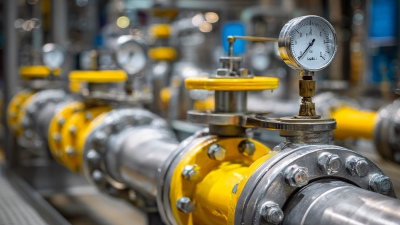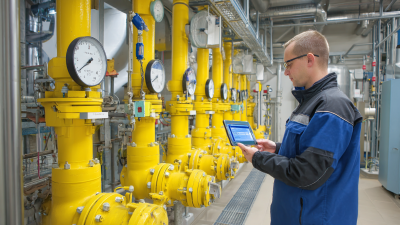Understanding Digital Flow Meters: The Key to Precision Measurement in Modern Industries
In today’s rapidly evolving industrial landscape, precision measurement is paramount for optimizing operations and ensuring product quality. A critical component in achieving this precision is the Digital Flow Meter, which offers advanced capabilities over traditional measurement tools. These devices not only enhance accuracy but also provide real-time data, enabling businesses to make informed decisions swiftly. As industries increasingly rely on automated processes and data-driven insights, understanding the intricacies of Digital Flow Meters becomes essential.

This introduction aims to delve into the significance of these devices, exploring their functionality, applications, and the advantages they bring to modern industry stakeholders. With the ability to monitor and manage flow rates effectively, Digital Flow Meters are establishing themselves as invaluable assets in the pursuit of operational excellence.
Exploring the Fundamentals of Digital Flow Meter Technology
Digital flow meters represent a significant advancement in measurement technology, offering precise and reliable data for various industries. At their core, these devices utilize advanced sensor technology to provide accurate flow measurement of liquids and gases. This precision is critical for industrial applications, where even minor deviations can lead to inefficiencies or losses. The integration of sensor technology allows for real-time monitoring and control, enabling industries to optimize their processes and enhance productivity.
Drawing parallels with the evolution of bio-inspired sensors found in aquatic environments, the fundamentals of digital flow meter technology highlight a growing trend towards smarter systems. Just as underwater detectors leverage biological principles for enhanced performance, digital flow meters harness innovative sensor designs that mimic natural systems. This approach not only improves measurement accuracy but also provides essential data for autonomous control systems, ensuring that industries can adapt swiftly to changing operational conditions. The exploration of these technologies presents exciting opportunities for enhancing precision measurement and efficiency across diverse sectors.

Key Features and Advantages of Modern Digital Flow Meters
Modern digital flow meters are essential tools for achieving precision measurement in various industries, enhancing the accuracy of fluid flow monitoring. One of their key features is the ability to leverage advanced technologies such as electromagnetic and ultrasonic measurements. These technologies facilitate real-time data collection, enabling industries to monitor fluid dynamics with unmatched accuracy. By eliminating mechanical parts, digital flow meters also reduce wear and tear, leading to lower maintenance costs and increased lifecycle longevity.
Moreover, the integration of digital flow meters within the Internet of Things (IoT) ecosystem enhances their capabilities. With smart sensors, these devices can transmit flow data directly to centralized management systems, allowing for comprehensive analysis and streamlined decision-making. This digital connectivity not only improves operational efficiency but also plays a vital role in sustainable practices by optimizing resource usage. As industries face increasing demands for data-driven insights, the adoption of modern digital flow meters becomes pivotal for maintaining competitiveness and ensuring reliability in fluid management processes.
Applications of Digital Flow Meters in Various Industries
Digital flow meters are increasingly becoming essential tools across various industries due to their precision and reliability in measuring fluid flow. Applications range from municipal water supply systems to complex industrial processes, where accurate flow measurement is critical for efficiency and operational safety. Recent industry reports project the global flow meters market to grow from USD 8.77 billion in 2025 to USD 13.77 billion by 2033, with a compound annual growth rate (CAGR) of 5.8%. This growth is fueled by advancements in technology and the rising demand for accurate flow data in sectors such as agriculture, healthcare, and environmental monitoring.
In the water and wastewater sectors, innovative solutions like easy-to-use electromagnetic flowmeters are becoming standard. These devices simplify workflow management and enhance data analytics capabilities, which are crucial for effective resource management. Additionally, emerging technologies such as AI-based leak detection systems are revolutionizing flow measurement. These systems analyze real-time data to identify inefficiencies and potential losses, thus further optimizing operational practices.
Tip: When selecting a flow meter, consider the specific requirements of your application, including flow rate, pressure, and the type of fluid being measured. Ensuring compatibility with existing systems can significantly enhance measurement accuracy and utility. Moreover, keep an eye on evolving IoT solutions, as they offer unprecedented insights into flow management and can help mitigate issues related to non-revenue water.
Comparing Digital Flow Meters with Traditional Measurement Methods
Digital flow meters have revolutionized the way industries measure the flow of liquids and gases. Unlike traditional measurement methods such as mechanical flow meters, which rely on moving parts to gauge flow rates, digital flow meters utilize advanced technology that provides greater accuracy and reliability. The precision of digital meters is crucial, especially in sectors where exact measurements can influence safety and efficiency, such as pharmaceuticals or food processing.
Moreover, digital flow meters offer real-time data monitoring and the ability to integrate with automated systems, facilitating improved process management. Traditional methods often require manual interventions and lead to time delays, while digital solutions enhance operational efficiency. By utilizing sensors and advanced algorithms, digital flow meters also minimize the potential for human error, leading to more consistent results over time. This technological shift not only enhances measurement precision but also represents a significant improvement in the overall effectiveness of industrial operations.
Understanding Digital Flow Meters vs Traditional Measurement Methods
Future Trends in Digital Flow Meter Innovations and Developments
 As we delve into the future trends in digital flow meter innovations, it's evident that technological advancements are set to redefine precision measurement across various industries. One significant trend is the integration of IoT (Internet of Things) capabilities, allowing for real-time monitoring and analytics. This connectivity not only enhances data accuracy but also enables predictive maintenance, significantly reducing downtime and operational costs. Manufacturers are increasingly adopting wireless communication protocols to facilitate seamless data transfer, which is essential in environments where traditional wiring is impractical.
As we delve into the future trends in digital flow meter innovations, it's evident that technological advancements are set to redefine precision measurement across various industries. One significant trend is the integration of IoT (Internet of Things) capabilities, allowing for real-time monitoring and analytics. This connectivity not only enhances data accuracy but also enables predictive maintenance, significantly reducing downtime and operational costs. Manufacturers are increasingly adopting wireless communication protocols to facilitate seamless data transfer, which is essential in environments where traditional wiring is impractical.
Tip: When selecting a digital flow meter, consider models that incorporate IoT capabilities for enhanced monitoring and easy integration with existing systems.
Another emerging trend is the development of advanced materials and designs that improve sensor durability and performance in harsh conditions. Companies are experimenting with composite materials that can withstand temperature fluctuations and corrosive substances, ensuring longevity and reliability in measurements. Furthermore, machine learning algorithms are being developed to enhance calibration processes, adapting to changes in the fluid being measured for even more precise readings.
Tip: Regular calibration and maintenance of your flow meter can help leverage the latest advancements in sensor technology, ensuring optimal performance and accuracy.
Related Posts
-

What is the Working Principle of a Turbine Flow Meter
-

Ultimate Guide to Understanding Gas Flow Meter Variations for Optimal Selection
-

How to Choose the Right Inline Flow Meter for Your Industrial Applications
-

Ultimate Guide to Choosing the Best Inline Flow Meter for Your Industrial Needs
-

Ultimate Guide to Understanding Different Flow Meter Types for Your Business Needs
-

7 Expert Tips for Selecting the Best Mag Meter for Your Industry
